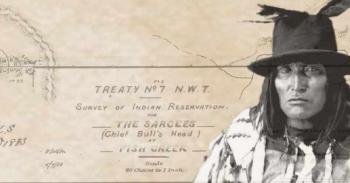By Shari Narine
Windspeaker.com Contributor
TSUUT’INA FIRST NATION, Alta.
The Tsuut’ina First Nation has filed a statement of concern with the province saying it “vigorously opposes” berm work proposed by Rocky View County along the Elbow River by Bragg Creek.
A study undertaken by the southern First Nation in response to the proposed work indicates that in the event of a catastrophic flood, larger debris could be carried downstream, overtop banks, reshape the river and its flow, and result in the “potential for a deeper ecosystem change” on the Tsuut’ina First Nation.
The nation’s legal counsel filed the statement with Alberta Environment and Parks on April 18, almost two weeks ahead of engagement sessions scheduled by Rocky View County with Tsuut’ina First Nation.
The project proposed by Rocky View County is the latest action it has taken to ensure its lands don’t flood out again like what happened in spring 2013.
Engagement sessions planned for April 30 are not good enough, said Tsuut’ina First Nation spokesman Kevin Littlelight, especially in view of both the Calls to Action from the Indian Residential School Truth and Reconciliation Commission and Alberta’s endorsement of the United Nation’s Declaration on the Rights of Indigenous Peoples.
“(Municipal Districts) and cities, they’re not adhering to the United Nations Declaration on the Rights of Indigenous Peoples and they’re not adhering to Truth and Reconciliation responsibilities,” said Littlelight. “They’re acting like we’re invisible people. So they’re ignoring us. They’re ignoring these world documents. They’re making decisions and have zero consultation with First Nations, in this case Tsuut’ina.”
Of the TRC’s 94 Calls to Action, the Federation of Canadian Municipalities identified nine as pertaining to municipal governments, including “fully adopt(ing) and implement(ing) the United Nations Declaration on the Rights of Indigenous Peoples as the framework for reconciliation.”
Numerous articles in UNDRIP call for Indigenous peoples to control their lands, including Article 26, which states, in part, “Indigenous peoples have the right to own, use, develop and control the lands, territories and resources that they possess by reason of traditional ownership or other traditional occupation or use, as well as those which they have otherwise acquired.”
Littlelight said he is tired of the approach federal, provincial and municipal governments take when it comes to consultation.
“First Nations believe consultation is sharing responsibility and approval, but the other side of the fence, they always believe consultation is shaking hands with First Nations, smiling and giving them a token little pin or coffee mug. That’s their consultation. It’s always been that way and I don’t see that changing,” he said.
Littlelight contends that Rocky View County should have been working hand-in-hand with the Tsuut’ina Nation, despite the fact that all proposed work occurs off-reserve. That work can potentially impact the First Nation, which is located downstream.
“If they’re just going to talk to us and their minds are already made up, of course, that’s too late,” said Littlelight.
In response to Tsuut’ina’s concerns, Shannon Phillips, provincial minister of environment and parks, issued a statement April 18, saying:
“The government of Alberta continues to consult with all Treaty 7 First Nations on this important project. We have just received this submission from the Tsuut’ina Nation. It will be assessed in our review process and considered as we move forward with decision making.
“I understand Alberta Transportation plans to move forward with discussions and planning of the Redwood Meadows flood mitigation project with the Tsuut’ina Nation in the near future. We remain committed to the Springbank Off-Stream Reservoir for mitigating flood impacts and protecting residents in Calgary and other downstream communities.”
Littlelight thinks the Nation’s concerns need a federal response.
“Alberta may be sitting there, but they’re not the end-all, be-all,” said Littlelight. “We call on the federal government to step in and advocate for the First Nation and advocate for our engineering studies.”
That study, undertaken by PGL Environmental Consultants, contends that Rocky View County’s documents for the berm work “do not contain sufficient information to adequately assess several downstream effects, particularly those associated with high and extreme flows. To adequately support the application’s conclusions that there will be no significant downstream effects, additional information is required.”
“They have zero respect for us that they can just do this. It’s another chapter in water and how non-Native governments behave with water in regard to Aboriginal people. In this day and age, it’s disgusting,” said Littlelight.
Rocky View County did not respond to requests from Windspeaker.com for comment.

